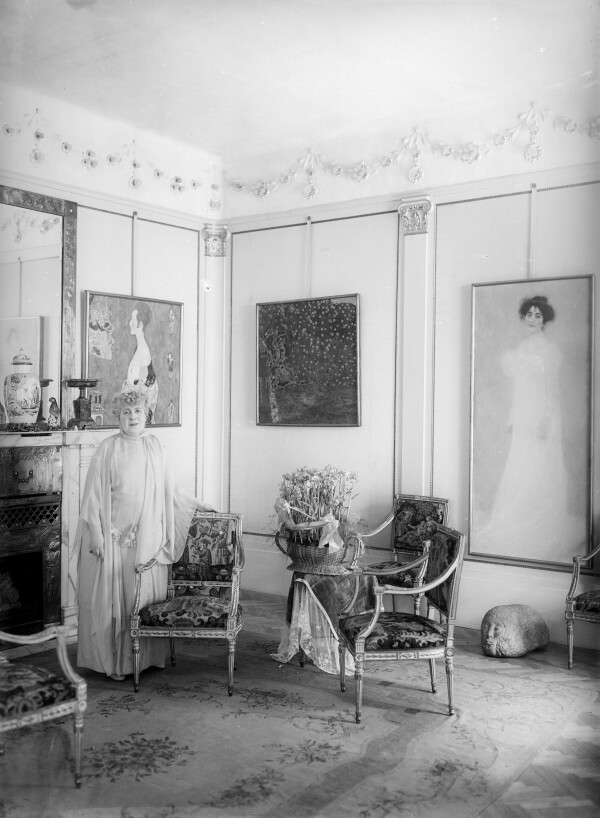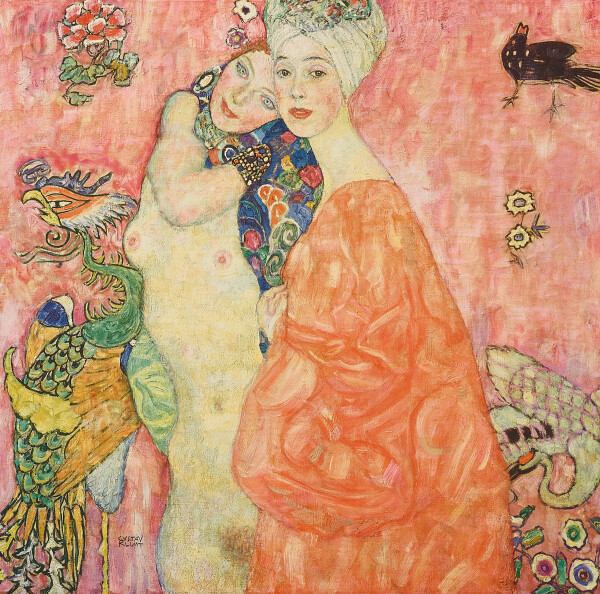The Lederer Family

Martin Gerlach: Insight into the apartment of Serena and August Lederer, 1920s - 1930s, Österreichische Nationalbibliothek, Bildarchiv und Grafiksammlung
© Picture Archives and Graphics Department, Austrian National Library

Gustav Klimt: Portrait of Elisabeth Lederer, 1914-1916, private collection
© Klimt Foundation, Vienna

Martin Gerlach: Insight into the apartment of Serena and August Lederer, 1920s - 1930s, Österreichische Nationalbibliothek, Bildarchiv und Grafiksammlung
© Picture Archives and Graphics Department, Austrian National Library

Gustav Klimt: Friends II, 1916/17, 1945 in Schloss Immendorf verbrannt, in: Max Eisler (Hg.): Gustav Klimt. Eine Nachlese, Vienna 1931.
© Klimt Foundation, Vienna

Gustav Klimt: Garden Path with Chickens, 1916, 1945 in Schloss Immendorf verbrannt
© Klimt Foundation, Vienna

Immendorf Castle
© Klimt Foundation, Vienna
The Lederer family was among Gustav Klimt’s most important patrons. The family’s exquisite art collection included chief works by the Jugendstil painter, which are representative of the various periods in the artist’s oeuvre, as well as numerous drawings. The majority of works from this eminent collection was destroyed in a disastrous fire at Immendorf Castle.
The Jewish industrial magnate August Lederer, who was born on 3 May 1857, made his fortune by taking over and managing the Raab (now Györ) and Jungbunzlau distillery. He was married to Serena (Szerena, Sidonie) Pulitzer, who was born on 20 May 1867. The “Grande Dame,” who Josef Hoffmann considered the “best-dressed woman in Vienna,” was the driving force behind the compilation of the family’s exquisite art collection. The couple had one daughter, Elisabeth, who was born on 20 January 1894, as well as two sons, Erich, born on 13 September 1896, and Friedrich, born on 30 June 1899. Elisabeth and Erich, especially, took a keen interest in art.
Gustav Klimt and the Lederer Family
While Klimt first got in touch with his future patroness by incorporating Serena’s likeness in his painting Auditorium of the Old Burgtheater (1888, Wien Museum, Vienna), it was latest the commission for the work Portrait of Serena Lederer (1899, The Metropolitan Museum of Art, New York), shortly before the turn of the century, that marked the beginning of an alliance that would last almost 20 years. The commission was followed by several further family portraits, including Portrait of Elisabeth Lederer (1914–1916, private collection) and the likeness of Serena’s mother, Portrait of Charlotte Pulitzer (1917, whereabouts unknown, lost since the end of the War in 1945). When Klimt was working on the latter, he likely found himself in difficult financial circumstances, writing to Serena:
“Esteemed Madam! A silly letter – I beg your pardon? You know the circumstances! The painting will be finished on Tuesday or Wednesday – this is when the meagre rest of the fee will be due – I am waiting for it like the devil – for a poor soul! […] Several miserable days are to pass before then – is it possible to get 2000 to 3000 crowns earlier […].”
August Lederer indirectly supported Klimt when he withdrew from his commission – which Klimt had taken on in 1894 and which became more and more burdensome over the years – for the ceiling paintings for the large ceremonial hall (formerly auditorium) of Vienna University. In 1905, The Faculty Painting Philosophy (1900–1907, destroyed in a fire at Immendorf Castle in 1945), as well as the preparatory oil sketch, entered into the possession of the Lederer family. In 1919, following the deaths of Klimt and Kolo Moser, Lederer was able with the help of Egon Schiele to acquire Jurisprudence (1903–1907, destroyed in a fire at Immendorf Castle in 1945) for his collection. The compositional sketch for this Faculty Painting had been owned by the family since 1905.
Klimt and the Lederer family maintained a friendly relationship. The artist was regularly invited to lunch and dine with the family, and participated in their salons, which represented social highlights. Klimt further visited the family at their estate in Györ. For years, the Jugendstil painter gave Serena drawing lessons, as Schiele reported to Arthur Roessler in 1912: “Mrs. L. [Lederer] was Klimt’s pupil for 14 years, therefore, she is quite skilled, though her work is naturally unoriginal and uncreative.” The family’s daughter, Elisabeth, also had artistic talent, which Klimt fostered. At the age of 15, she started to train at the Imperial-Royal School of Arts and Crafts, under Michael Powolny and other teachers. Klimt, in turn, introduced the Lederer family to Schiele, who would find a supporter especially in Erich.
The Lederer Family’s Art Collection and Tragic Fate
The Lederer family owned several properties, including the Ledererschlössl (Vienna-Penzing, 14th District), which no longer exists today, as well as their estate in Györ. Their main residence was their apartment at Bartensteingasse 8 (Vienna-Innere Stadt, 1st District), in proximity to Gustav Klimt’s studio at Josefstädter Straße 21 (Vienna-Josefstadt, 8th District), which the artist used between 1890 and 1911. The family kept a large part of their extensive collection in this apartment. A room, designed especially for this purpose by Josef Hoffmann, Kolo Moser and Georg Klimt, housed Klimt’s Philosophy and other select works.
Aside from the afore-mentioned family portraits and Faculty Paintings, the Lederer Collection included the following works: Music (1897/98, destroyed in a fire at Immendorf Castle in 1945), Schubert at the Piano (1899, destroyed in a fire at Immendorf Castle in 1945), The Beethoven Frieze (1901/02, Belvedere, Vienna), From the Realm of Death (Stream of the Dead) (1903, whereabouts unknown, lost since the end of the War in 1945), Klimt’s landscapes The Golden Apple Tree (1903, destroyed in a fire at Immendorf Castle in 1945), Country Garden with Calvary (1912, destroyed in a fire at Immendorf Castle in 1945), Malcesine on Lake Garda (1913, whereabouts unknown, lost since the end of the War in 1945) and Garden Path with Chickens (1916, destroyed in a fire at Immendorf Castle in 1945), as well as the paintings Water Snakes I (Parchment) (1904, reworked: before 1907, Belvedere, Vienna), Friends II (1916/17, destroyed in a fire at Immendorf Castle in 1945), Portrait of Wally (1916, destroyed in a fire at Immendorf Castle in 1945), Leda (1917, destroyed in a fire at Immendorf Castle in 1945) and Gastein (1917, whereabouts unknown, lost since the end of the War in 1945). After Klimt’s death, Serena Lederer purchased another comprehensive mixed lot of Klimt drawings from Gustav Nebehay in 1919. That same year, she commissioned the publishers Gilhofer & Ranschburg to print a facsimile edition of the 25 most beautiful works on paper.
The emerging National Socialism brought immense reprisals not only for the Lederer family. The year 1939 also sealed the fate of their comprehensive collection, which was dispossessed. In 1943, Baldur von Schirach provided for the majority of the Klimt paintings to be displayed in the commemorative presentation “Gustav Klimt. Ausstellung” [“Gustav Klimt. Exhibition”] shown at the Vienna Secession, which was now called Friedrichstraße exhibition venue. However, the exhibition was cut short due to the threat of bombings. The bulk of the Lederer Collection – which also included works by other artists – was subsequently stored at Immendorf Castle in Lower Austria. During the last days of the War in May 1945, Austria sustained one of the most devastating losses of cultural goods in its history, when a fire destroyed the objects stored at the castle.
The paintings Portrait of Serena Lederer and Portrait of Elisabeth Lederer surfaced on the art market after the War, and were to be sold at auction in 1948 at the Viennese auctioneers Dorotheum. However, the sale was abandoned and both works were ultimately returned to Erich Lederer.
The Fate of the Lederer Family
August Lederer died on 30 April 1936 in Vienna. Serena Lederer died on 27 March 1943 in Budapest, where she had been forced to flee to. Elisabeth, who had divorced her husband Wolfgang Freiherr von Bachofen von Echt in 1938 and managed to escape persecution by the National Socialists owing to a faked family tree which stated Gustav Klimt as her biological father, died on 19 October 1944 from a severe illness. The sons Erich and Friedrich survived the horrors of World War II in exile. Friedrich died on 21 March 1972. Until the 1970s, Erich tried in vain to effect the return of the extensive Beethoven Frieze. He died on 19 January 1985 in Geneva. The members of the Lederer family were laid to rest at their crypt at Hietzing Cemetery, where Gustav Klimt is buried.
Literature and sources
- Christian M. Nebehay: Gustav Klimt. Sein Leben nach zeitgenössischen Berichten und Quellen, Vienna 1969, Zeile 142-143.
- Christian M. Nebehay: Gustav Klimt, Egon Schiele und die Familie Lederer, Berne 1987.
- Sophie Lillie: Was einmal war. Handbuch der enteigneten Kunstsammlungen Wiens, Vienna 2003, S. 657-671.
- Georg Gaugusch: Wer einmal war. Das jüdische Großbürgertum Wiens 1800–1938, Band 2, Vienna 2016, S. 1783-1788, S. 2579-2592.
- Tobias G. Natter (Hg.): Die Welt von Klimt, Schiele und Kokoschka. Sammler und Mäzene, Cologne 2003, S. 111-139.
- Karteikarte Nr. 31 der Galerie H. O. Miethke über den Verkauf einer Ölskizze für »Die Jurisprudenz« (02/18/1905).
- Karteikarte Nr. 32 der Galerie H. O. Miethke über den Verkauf einer Ölskizze für »Die Philosophie« (02/18/1905).
- Brief von Egon Schiele in Györ an Arthur Roessler (24.12.1912). H.I.N. 180.671.
- Ansichtskarte von Gustav Klimt in Wien an Emilie Flöge in Wien (27.10.1915). Autogr. 959/51-6, .
- Else Hofmann: Die Bildhauerin Elisabeth Bachofen-Echt, in: Österreichische Kunst, 5. Jg., Heft 4 (1934), S. 8-9.
- N. N.: Brief von Gustav Klimt an Serena Lederer, vermutlich 1917, Verbleib unbekannt, in: Tobias G. Natter (Hg.): Die Welt von Klimt, Schiele und Kokoschka. Sammler und Mäzene, Cologne 2003, S. 126.

